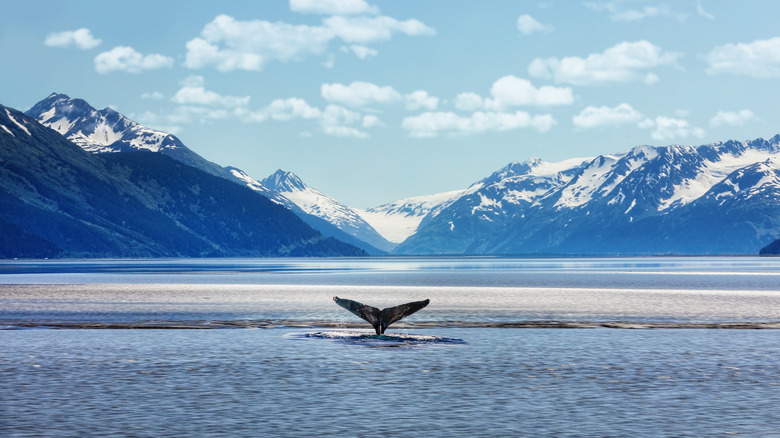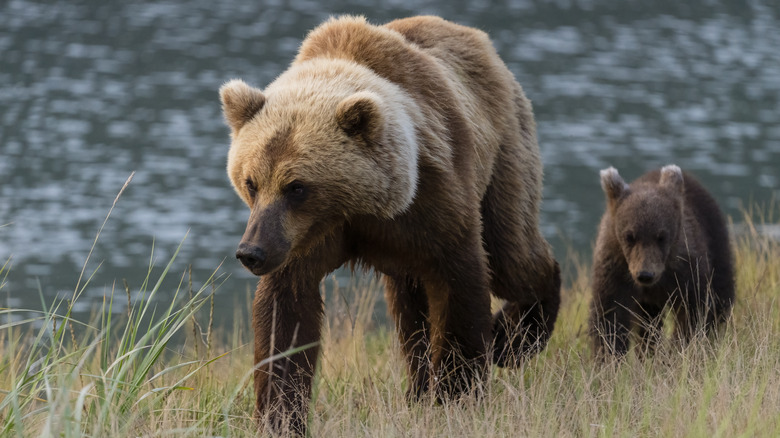This Stunning Alaskan Island Is The Perfect Destination For Wilderness Lovers
Alaska has the most islands of any state in America. This cold-weather beauty is home to over 2,500 islands strewn across its shoreline and peninsulas. But the most strikingly remote of them all? Unimak Island. The largest of the Aleutian Islands, Unimak Island is a string of islets that stretch from mainland Alaska out into the Pacific, over 1,100 miles long. Although there are countless tiny islets, there are only about 69 substantial islands in the Aleutians. In fact, Unimak is the very first island in the chain.
Originally inhabited by the Unangan First Nation, Unimak was later settled due to its abundance of salmon. The Sockeye Salmon Co. moved to False Pass in the early 20th century from the nearby Morzhovoi Bay. There is still a seafood processing plant on the island today. What draws in most visitors, aside from the intoxicating idea of visiting an uber-off-the-beaten-path destination, are its geographical features, like snow-covered volcanoes and dense wildlife. The island's biodiversity is impressive, with salmon streams, bald eagles, and whales, just to name a small portion of the animals you might see.
You'll find the windswept village of False Pass, the only settlement on the island, clinging to rocky shores and other scenic vistas of isolation. Just some of the epic landscapes you can expect include killer whales swimming in pristine bays and capes, smoke rolling out of volcanoes that punctuate the skyline and abandoned buildings situated along the coast.
What is there to do on Unimak Island?
There's no hiding it: Unimak Island is one of the most remote destinations in America. With only 60 year-round residents, a visit to this rugged isle is an exercise in isolation. Come to see the successful fishing industry in False Pass, the largest (and only) settlement on the island, or immerse yourself in Unangan culture. However, most visitors who make it to Unimak are there to see wildlife. Because this island is so secluded, animals have found solace here and thrive in the island's desolate landscapes. You'll see everything from grizzly bears to humpback whales swimming just offshore.
Another draw is the islands steaming volcanoes. Of the many volcanoes that dot the Aleutian Islands, three call Unimak Island home. The largest is the active volcano, Mount Shishaldin, which also happens to be the tallest peak in the Aleutian Islands at 9,373'.
If visitors make it to the isolated northern shores of Unimak Island, you'll be treated to black sand beaches and the Cape Sarichef Lighthouse. Created by the island's volcanic activity, these midnight shorelines continue to stretch east along the north coast of the island. Because the Aleutian Islands are a part of the Ring of Fire, you'll find black sand beaches on many of these Alaskan isles.
Tips for visiting Unimak Island
Visiting Unimak Island is only for true wilderness lovers, the adventurous at heart, and those who don't mind a lack of modern amenities. First off, getting to Unimak is difficult. The Alaska State Ferry makes a twice-monthly stop at False Pass, and seaplanes can be arranged to land here, too. Accommodation on the island is almost nonexistent — there's only one registered B&B — so cruising is one of your best options because you'll also get to explore more of the Aleutian Islands. Alaska is, after all, a favorite choice for honeymoon cruises.
Alaska is no doubt the best state in the U.S. for those who love to explore wilderness areas and national parks without the crowds. Visiting Unimak Island makes for a great addition to a trip out to the rugged Katmai National Park as you'll be in the same neck of the woods, near the start of the string of Aleutian Islands. Both of these secluded Alaskan destinations can't be reached by road but it is possible to connect the two by sea plane.
Unimak is also home to a dense population of grizzly bears. This means that you'll need to carry bear spray with you at all times in the backcountry, at the very minimum. The island is also home to other creatures like wolves, killer whales, and sea otters.


